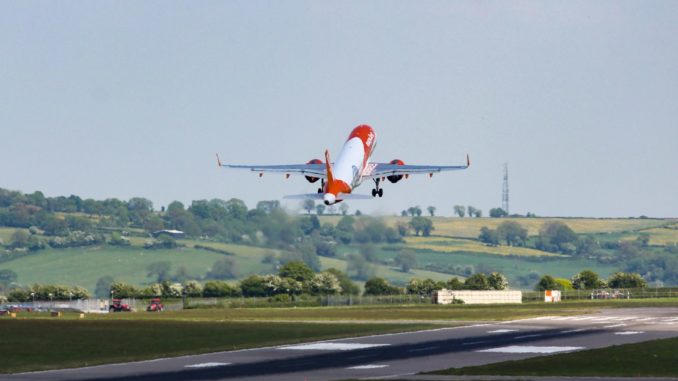
Dr Liam Fox MP has written a letter to the Chief Executive of North Somerset Council in which he says that without solving the problem of local transport infrastructure “it is difficult to see how further expansion beyond the current limit of 10 million passengers could be justified”
Bristol Airport is seeking permission from North Somerset Council to expand the airport from 10m passengers per year to 12m but its location sees it sat on the A38 around 8 miles from Bristol, a road notorious for traffic problems being single carriageway all the way.
The only current public transport options to the airport are bus links from Bristol and Weston-Super-Mare as well as further South with ‘The Falcon’.
Dr Fox, who is the MP for North Somerset, says in his letter “It seems that the lack of road transport is the most important rate-limiting step in potential expansion. It is difficult to envisage the level of improved road provision that would change this position or how much it might cost the taxpayer. A rail link is highly unlikely due to the topography and improved bus links from central Bristol will not be effective given the geographical starting point of passengers.”
Other factors set out by the MP include the impact of noise from an increase in flights which he says “must be a major consideration when determining the potential expansion of passenger numbers at Bristol airport.”. He also questions whether the benefit to the local economy is as great as suggested given that business travel accounts for a small percentage of passengers using the airport. In his view “It is highly likely that major international investors will continue to come via London”
North Somerset Council will make a decision on the expansion plans, which were recommended for approval by planners, on 10th February.
Dr Liam Fox’s Letter in Full
Dear Mrs Walker
I know that North Somerset Council will shortly be examining plans for the expansion of Bristol International Airport. I wish to make the following observations to this issue and would be grateful if they could be included.
BRISTOL AIRPORT EXPANSION
Bristol International Airport has been a great amenity and facility for our region and its people, including those in my constituency of North Somerset. It has improved our transport links, especially to Europe, and has been particularly popular with leisure travelers, including those taking family holidays. From a small regional hub it has successfully transformed into a genuinely international airport and has supported a large number of jobs both directly and indirectly.
Despite the difficulties that result from its natural topographical position and lack of direct transport links, the 2011 planning permission allows the airport to expand to 10 million passengers per annum. It is clear, however, that expansion cannot continue indefinitely so the question becomes one of balance. What is a reasonable limit for expansion that will ensure, on one hand, the viability of the airport and potential support for the local and regional economy without, on the other, creating undue pressure on the local environment and its population?
In its consultation document, “Aviation 2050: the future of UK aviation”, the government set out a number of aims and tests for regional aviation.
Local economy
In terms of the local economy the document pointed out that “airports can directly support thousands of jobs and generate economic benefits beyond the airport fence. Core and specialist aviation services, freight companies, logistics hubs and aerospace investment are often located close to airports, creating jobs in the local area. Regional airports also act as wider magnets attracting non-aviation businesses due to the air connections the airport offers but also the strong road and rail access links that support the airport. They act as a gateway to international opportunities for the regions of the UK”.
It is undoubtedly true that airports not only support jobs directly but can indirectly stimulate the local economy creating new companies and more employment opportunities. However, there are major restrictions on road access links in the case of Bristol airport and there are no rail access links at all.
A second aim set out in the document states that “the government recognises the importance of rebalancing the UK economy through the economic growth of the regions and ensuring that the UK remains competitive after we leave the EU. Through the Industrial Strategy, the government has set out its ambition to create a geographically-balanced economy that works for everyone”.
There are few, if any, who do not want to see a rebalancing of the economy across the UK, but one of the key issues that Bristol airport needs to address is the very small number of business passengers, as a proportion of the total, who pass through the airport. The proximity of London Heathrow with its far more frequent services and wider range of destinations makes it a much more natural entry and exit point for business travellers. This is likely to become more so as the newly improved rail service from Bristol is connected directly with Heathrow. It is hard therefore to make the case that expansion of Bristol airport would lead to an improvement in the regional economy. It is highly likely that major international investors will continue to come via London, not least because of its world leading financial services.
Local transport infrastructure
Perhaps the single biggest impediment to expansion passenger numbers at Bristol airport is the local transport infrastructure. Our historical legacy, for a number of reasons, is that our major transport routes run from north to south – the M5, A370 and A38. There are no major West to East roads and so passengers coming to the airport have to travel through local towns and villages where there has been a major impact on road traffic. This is unavoidable when around 85% of Bristol airport passengers come by road transport. Figures produced by the airport show the following regional distribution for its passengers: West of England 35%, South Wales 20%, Devon 14%, Somerset 10%, Gloucestershire 7%, Wiltshire 7%, Cornwall 5%, Dorset 2%.
This means that a large number of passengers have to come via the M5 and leave at junctions 18, 19, 20 and 21. New restrictions in Bristol on air pollution from vehicles is likely to increase the amount of traffic using junctions 19 (already overcrowded due to the considerable expansion of Portishead), 20 and 21. This will mean considerable additional pressure on local roads which will have knock-on effects on roadside pollution and potentially on road safety where local schools are situated adjacent to main roads.
It seems that the lack of road transport is the most important rate limiting step in potential expansion. It is difficult to envisage the level of improved road provision that would change this position or how much it might cost the taxpayer. A rail link is highly unlikely due to the topography and improved bus links from central Bristol will not be effective given the geographical starting point of passengers.
If this problem cannot be solved, it is difficult to see how further expansion beyond the current limit of 10 million passengers could be justified.
Noise
Modern aircraft have become much quieter and future technological change should improve the position even further. While aircraft noise is not an issue for the vast majority of passengers who use Bristol airport and usually not an issue for most North Somerset residents, it can produce a significant reduction in the quality-of-life for those who live directly under the flight path or adjacent to the airport itself. There has been a recent pattern of routinely setting noise caps as part of planning approvals (for increase in passengers or flights). Limiting the impact of noise must be a major consideration when determining the potential expansion of passenger numbers at Bristol airport.
The government’s consultation document states that “the aim is to balance noise and growth and to provide future certainty over noise levels to communities. It is important that caps are subject to periodic review to ensure they remain relevant and continue to strike a fair balance by taking account of actual growth and the introduction of new aircraft technology. It is equally important that there are appropriate compliance mechanisms in case such caps are breached and the government wants to explore mechanisms by which airports could ‘pay for’ additional growth by means of local compensation as an alternative to the current sanctions available “.
Government plans will require all major airports to set out a plan which commits to future noise reduction, and to review this periodically. This would only apply to airports which do not have a noise cap approved through the planning system and would provide similar certainty to communities on future noise levels. The government wants to see better noise monitoring and a mechanism to enforce these targets as for noise caps. The noise action planning process could potentially be developed to provide the basis for such reviews, backed up by additional powers as necessary for either central or local government or the CAA. In order to help facilitate these changes the government has established a new Independent Commission on Civil Aviation Noise. ICCAN will advise the government on best practice on noise mitigation, and how the needs of affected communities can best be served in the airspace modernisation programme. The government has committed to review ICCAN’s powers within two years and this will include the possibility of putting it on a statutory footing. I would support this as I believe it has the potential to act as an empowering mechanism for local communities in the future.
Parking
One of the most controversial aspects of the current expansion to 10 million passengers at Bristol airport relates to parking at the airport itself and its impact on local villages. Until the full parking facilities, promised by the airport’s owners and management, which were part of the previous conditions on expansion are met, it is reasonable to rule out any further expansion. The net effect of inadequate parking provision within the airport perimeter has been the displacement of parking into illegal sites, including on greenbelt, which has been difficult and expensive for the local authority to police. Residents of local villages have seen airport passengers park outside their properties, often for long periods, and use taxi services to and from the airport. The development of a substantial park-and-ride facility adjacent to the M5, which has been proposed and which I support, could see not only improved parking opportunities but would enable the use of more environmentally friendly transport with far fewer vehicle movements through adjacent villages and residential areas.
These issues are all directly applicable to this particular planning process and do not take account of generic issues surrounding aviation which are widely discussed elsewhere. It is essential that these specific problems are addressed by airport authorities and North Somerset Council before any decision on Bristol Airport Limited’s current planning application is taken.
Thank you.
Yours sincerely
LIAM FOX
Parliamentary Office of the Rt Hon Dr Liam Fox MP
